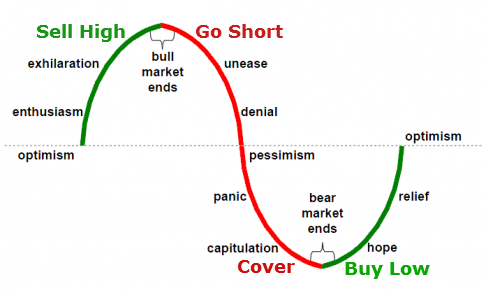
Continuation from Friday……..(Buy Low, Sell High, Go Short & Cover Summary)
Making the Buy Low, Sell High, Go Short & Cover approach the best investment strategy for all types of investors. For the following reasons.
Risk Reduction:
- Through the purchase of undervalued securities.
- Through knowing where in the cycle you are.
- Though having the ability to be on both sides of the trade at appropriate times.
Maximizing Profits:
- Through having the ability to profit from both sides of the move. Long and short.
- Through purchasing undervalued securities with significant upside potential or shorting overvalued securities with a lot downside.
- Through compressing anticipated gains into the shortest time frame possible.
A number of examples were provided to verify the strategy. For instance, it was shown that the Buy & Hold investment strategy would yield a ROI of 525% between 1994 bottom and today through an investment in the Nasdaq. By comparison, the Buy Low, Sell High, Go Short & Cover investment strategy would yield a total compounded return of 8,015% during the same period of time. A final return that is 15 times higher than what most investors were able to achieve if they were lucky enough to hold on to their positions over the last 20 years. Most importantly, this higher return was obtained while minimizing risk.
Finally, the strategy above can be applied towards most financial instruments and in all market conditions. Once investors determine exactly where they are in the overall cyclical composition of the move, top or bottom, they can initiate an appropriate position when the confirmation is obtained. Then move in and out as the strategy dictates.
The best part about the Buy Low, Sell High, Go Short & Cover investment strategy is the returns it offers. The two examples provided in this book are nothing but a scratch on the surface of what’s possible. If given more time and through proper application of the techniques described in this book, the returns on both investments should expand exponentially. And that’s just the start. Investors or traders that work with shorter time frames might be able to move in and out more frequently, compounding their returns even faster.
In conclusion, the approach presented in this book forces investors to move with the market and not against it. And that is contrary to what most investor tend to do. It is well known fact that most investors tend to pile in right at the top or when they feel the most optimistic, only to liquidate their positions near the bottom. Our Buy Low, Sell High, Go Short & Cover investment strategy forces investors to do exactly the opposite. It forces them to move with the market at all times and in all market conditions. Minimizing the risk and guaranteeing outsized returns in the process.






